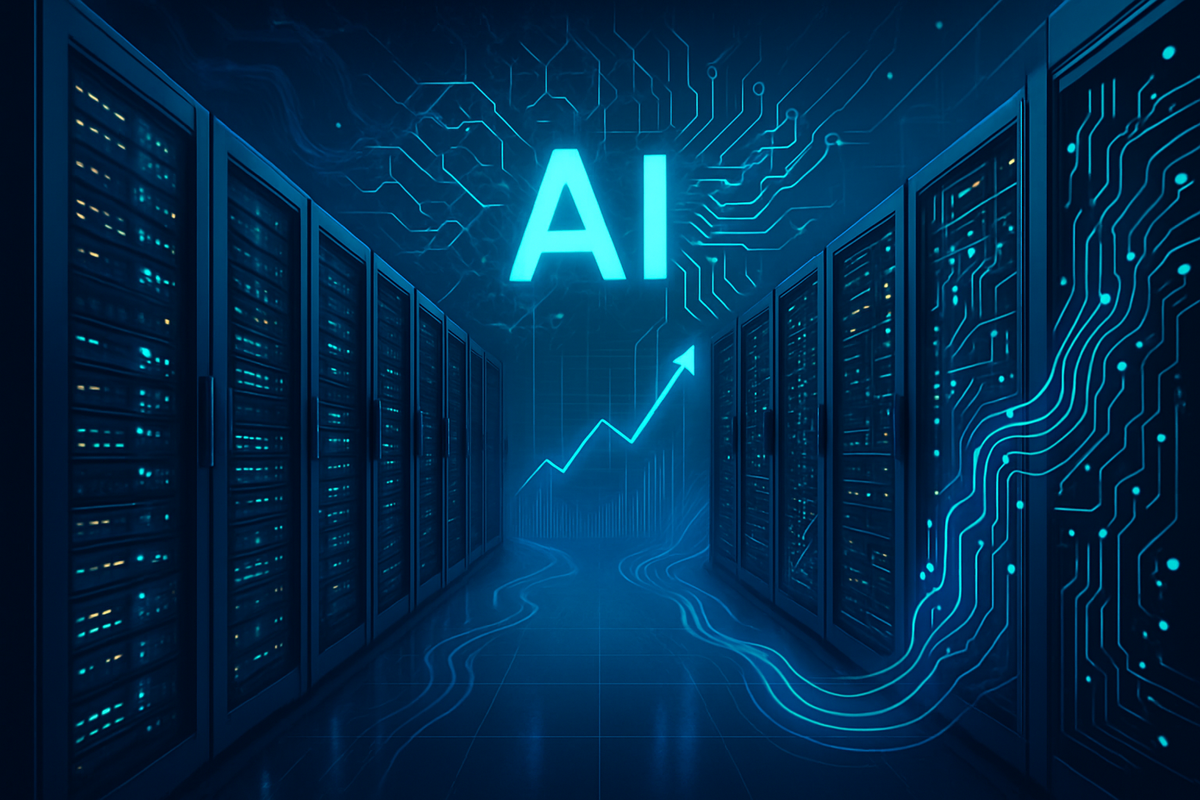
Applied Digital (NASDAQ: APLD) has emerged as a beacon in the burgeoning artificial intelligence (AI) infrastructure landscape, experiencing a remarkable stock surge that underscores the profound shift occurring within the tech sector. Its recent financial performance, highlighted by an 84% year-over-year revenue increase to $64.2 million in the first quarter of fiscal year 2026, has not only surpassed analyst expectations but also cemented its position as a critical "AI Landlord." This surge is a direct reflection of the escalating demand for specialized data centers capable of powering intensive AI workloads, signaling a new gold rush for the foundational components of the AI revolution.
The company's strategic pivot from cryptocurrency hosting to high-performance computing (HPC) data centers has resonated strongly with investors, particularly following significant deals, such as the expanded 15-year lease agreement with AI hyperscaler CoreWeave, projected to generate $11 billion in revenue. This development, coupled with a strategic investment from NVIDIA (NASDAQ: NVDA), illustrates a broader market trend where the physical infrastructure supporting AI is becoming as crucial as the AI models themselves. Applied Digital's trajectory offers a compelling case study of how companies are adapting to and capitalizing on the AI boom, with immediate implications for valuation models, investment strategies, and the competitive dynamics across the technology industry.
The Genesis of an AI Infrastructure Giant
Applied Digital's transformation and subsequent market ascent are rooted in a series of strategic maneuvers that began to accelerate in late 2024. The company, initially known for its cryptocurrency mining operations, recognized the immense potential and growing demand for high-density, AI-ready data center capacity. This foresight led to a decisive pivot, rebranding its mission and retooling its facilities to cater specifically to the power-intensive demands of artificial intelligence.
A pivotal moment arrived in October 2024 when NVIDIA (NASDAQ: NVDA) made a strategic investment of $160 million in Applied Digital through a private placement. This endorsement from the leading AI chipmaker sent a clear signal to the market, causing APLD's stock to surge by an astounding 150% and validating its new direction. This initial spark ignited a continuous climb throughout early 2025, with the stock gaining 163% by the year's midpoint, fueled by increasing investor confidence in the AI infrastructure sector.
The momentum intensified significantly in June 2025 with the announcement of a landmark deal with CoreWeave, a prominent AI hyperscaler. This agreement committed Applied Digital to provide 250 megawatts (MW) of data center capacity, a deal initially projected to yield approximately $7 billion in revenue over 15 years. Just a month later, in July 2025, this partnership was further cemented and expanded, bringing the total contracted capacity at its Polaris Forge 1 campus to 400 MW, securing an impressive $11 billion in future lease revenue over the same 15-year period. These long-term, high-value contracts have provided Applied Digital with unprecedented revenue visibility and financial stability.
By October 9-10, 2025, the company's strategic shift culminated in a significant market reaction to its fiscal first-quarter 2026 results. Reporting an 84% year-over-year revenue increase to $64.2 million, significantly exceeding analyst expectations, and an adjusted EPS of -$0.03 (better than the projected -$0.14), Applied Digital's stock surged approximately 17-26% in pre-market and after-hours trading. This robust performance was directly attributed by CEO Wes Cummins to the "surging demand for data center services to support generative AI applications," reinforcing the company's successful transition and its critical role in the AI ecosystem.
The Shifting Sands: Identifying Winners and Losers in the AI Infrastructure Race
The rapid ascent of Applied Digital (NASDAQ: APLD) serves as a potent illustration of how the AI revolution is redrawing the lines of profitability and strategic advantage within the technology sector. In this new landscape, companies providing the foundational infrastructure for AI are poised to be significant winners, while those unable to adapt or offer complementary services may face increasing pressure.
The Winners:
Companies like Applied Digital, specializing in high-performance computing (HPC) data centers and AI-ready infrastructure, are clear beneficiaries. Their ability to provide the specialized power, cooling, and connectivity required for intensive AI workloads makes them indispensable. Other potential winners include:
- AI Hyperscalers (e.g., CoreWeave, Microsoft (NASDAQ: MSFT) Azure, Amazon (NASDAQ: AMZN) AWS, Alphabet (NASDAQ: GOOGL) Google Cloud): These companies are the direct consumers of AI infrastructure, driving demand for data center capacity. Their success in deploying and offering AI services directly fuels the growth of infrastructure providers.
- Chip Manufacturers (e.g., NVIDIA (NASDAQ: NVDA), AMD (NASDAQ: AMD)): As the architects of AI processing power, these companies continue to see unprecedented demand for their GPUs and other AI accelerators. Their innovation directly underpins the need for advanced data centers.
- Power and Cooling Solutions Providers: The immense power consumption and heat generation of AI data centers create a booming market for companies offering advanced power management systems, liquid cooling technologies, and energy-efficient designs.
- Real Estate Investment Trusts (REITs) with Data Center Portfolios: REITs that own and operate data centers capable of upgrading to AI-ready specifications stand to benefit from increased leasing rates and demand.
The Losers (or those facing significant challenges):
The AI infrastructure boom also presents challenges for certain segments and companies:
- Legacy Data Center Operators (without AI focus): Traditional data centers not equipped for high-density AI workloads, lacking advanced cooling, or unable to scale power efficiently, may find themselves at a disadvantage. Upgrading these facilities requires substantial capital expenditure.
- Companies reliant solely on general-purpose cloud computing: While general cloud services will remain vital, the specialized nature of AI workloads often necessitates purpose-built infrastructure. Companies unable to offer or access these specialized environments might face performance bottlenecks or higher costs.
- Cryptocurrency Mining-focused entities (without diversification): As seen with Applied Digital's pivot, companies solely focused on crypto mining without diversifying into other HPC applications, particularly AI, risk being left behind as market dynamics shift and profitability margins fluctuate.
- Energy Providers (without renewable focus): The massive energy demands of AI data centers will put pressure on energy grids. Companies providing energy without a strong emphasis on sustainable and renewable sources may face regulatory hurdles or public scrutiny.
The impact on these companies is direct: winners will see increased revenue, higher stock valuations, and opportunities for expansion, while those unable to adapt may experience declining market share, reduced profitability, and investor skepticism. The ability to innovate and strategically align with the burgeoning AI ecosystem will be the defining factor for success in the coming years.
Broader Significance: AI's Reshaping of the Industrial Landscape
Applied Digital's (NASDAQ: APLD) meteoric rise transcends a mere company success story; it embodies a profound, systemic shift in the broader technology and industrial landscape driven by artificial intelligence. This event is not an isolated incident but a powerful indicator of several overarching industry trends, with significant ripple effects across competitors, partners, and even regulatory bodies.
Firstly, this surge underscores the critical importance of physical infrastructure as the backbone of the AI revolution. For years, the focus has been on AI algorithms and software. Now, the bottleneck has shifted to the availability of specialized, high-density computing environments. As CEO Wes Cummins aptly puts it, "The limiting factor in AI infrastructure deployment is no longer GPU availability, it's lack of data centers." This realization is compelling hyperscalers and enterprises alike to invest heavily in purpose-built facilities, creating a burgeoning market for "AI landlords" like Applied Digital. This trend forces traditional data center operators to either adapt their existing facilities or risk obsolescence.
Secondly, the event highlights the growing trend of strategic partnerships and ecosystem integration. NVIDIA's (NASDAQ: NVDA) investment in Applied Digital and CoreWeave's extensive leasing agreements are prime examples. These collaborations are not just transactional; they represent deep strategic alignments where chipmakers, infrastructure providers, and AI developers work in concert to accelerate deployment and innovation. This symbiotic relationship is crucial for managing the immense capital expenditure and technical complexity involved in scaling AI capabilities, potentially leading to further consolidation or specialized alliances within the sector.
Thirdly, the energy demands of AI infrastructure are bringing sustainability and regulatory implications to the forefront. High-performance AI data centers consume vast amounts of electricity, raising concerns about environmental impact and grid stability. Applied Digital's focus on energy-efficient designs, such as a low Power Usage Effectiveness (PUE) and advanced cooling systems, signals an industry-wide imperative to address these concerns. Regulators and policymakers are likely to increase scrutiny on data center energy consumption, potentially leading to new environmental standards, incentives for renewable energy integration, or even geographical restrictions on data center development.
Historically, this AI infrastructure boom draws parallels to the dot-com bubble of the late 1990s and early 2000s, where foundational internet infrastructure companies saw massive valuations. However, a key difference lies in the tangible and immediate economic value being generated by AI, which is already transforming industries from healthcare to finance. Another comparison can be made to the cloud computing build-out of the 2010s, where companies like Amazon (NASDAQ: AMZN) Web Services and Microsoft (NASDAQ: MSFT) Azure invested heavily in general-purpose cloud infrastructure. The current AI wave is a more specialized, power-intensive iteration of that build-out, demanding even greater technical precision and capital.
The wider significance of Applied Digital's success is that it validates the thesis that the "picks and shovels" providers of the AI era are just as, if not more, crucial than the gold miners themselves. It signals a robust, long-term investment cycle in foundational computing infrastructure, reshapes competitive landscapes, fosters new strategic alliances, and brings critical environmental and regulatory considerations to the forefront of technological advancement.
What Comes Next: Navigating the Future of AI Infrastructure
The trajectory set by Applied Digital's (NASDAQ: APLD) surge provides a compelling glimpse into the future of AI infrastructure, outlining both immense opportunities and significant challenges. The coming years will be defined by aggressive expansion, technological innovation, and a constant re-evaluation of market dynamics.
In the short-term (1-2 years), we can expect a continued scramble for high-density data center capacity. Applied Digital itself has already begun construction on Polaris Forge 2, a 300 MW facility slated for partial operation by 2026 and full completion by 2027. This rapid expansion will be mirrored by competitors and new entrants, all vying to capture a piece of the hyperscalers' estimated $350 billion annual investment in AI deployment. Market opportunities will arise for specialized construction firms, equipment manufacturers for advanced cooling and power, and potentially for companies offering novel energy solutions. However, challenges will include securing adequate land, power supply, and skilled labor, alongside managing the intense capital expenditure required for such rapid growth.
Long-term (3-5+ years) possibilities point towards a global arms race in AI infrastructure. Applied Digital's ambition to grow beyond 1 gigawatt by 2028-2030, coupled with explorations into new geographic expansions, suggests a future where AI data centers become a critical component of national and economic security. This will likely lead to further consolidation in the infrastructure provider space, as smaller players may struggle to compete with the scale and funding of giants. Strategic pivots for existing companies might involve deeper integration with AI software layers, offering not just raw compute but also managed AI services, or specializing in niche AI applications that require unique infrastructure setups.
Potential strategic pivots and adaptations required will focus on efficiency and sustainability. The massive power consumption of AI workloads necessitates continuous innovation in cooling technologies (e.g., direct-to-chip liquid cooling, immersion cooling) and renewable energy integration. Companies that can offer the most energy-efficient and environmentally responsible solutions will gain a significant competitive edge. Furthermore, the ability to rapidly deploy and scale infrastructure while maintaining high levels of security and reliability will be paramount.
Market opportunities will emerge in edge AI infrastructure, as processing moves closer to data sources to reduce latency and bandwidth costs. This could open doors for smaller, distributed data center solutions. Conversely, challenges will include managing the increasing complexity of global supply chains for specialized hardware and navigating a potentially fragmented regulatory landscape as different nations grapple with data sovereignty and AI governance. Potential scenarios range from a highly centralized AI infrastructure dominated by a few global players to a more distributed model driven by edge computing. The outcome will depend on technological advancements, regulatory frameworks, and geopolitical factors.
Comprehensive Wrap-up: The Enduring Impact of the AI Infrastructure Boom
The remarkable journey of Applied Digital (NASDAQ: APLD) from a cryptocurrency miner to a pivotal AI infrastructure provider encapsulates the most significant market transformation of our era. The key takeaway is unequivocal: the artificial intelligence revolution is not just about sophisticated algorithms or powerful chips; it is fundamentally dependent on a robust, specialized physical infrastructure capable of sustaining its immense computational demands. Applied Digital's surge, driven by strategic pivots and massive contracts with AI hyperscalers like CoreWeave, underscores the critical role of these "AI landlords" in enabling the future of technology.
Moving forward, the market is poised for sustained growth in the AI infrastructure sector. The demand for high-performance computing (HPC) data centers, equipped with advanced cooling and substantial power capabilities, will continue to outpace supply for the foreseeable future. This creates a fertile ground for companies like Applied Digital, which are aggressively expanding their footprint and securing long-term contracts. Investors should assess companies not just on their AI software prowess but also on their tangible assets and strategic positioning within the infrastructure layer. The ability to provide the "picks and shovels" for the AI gold rush will be a defining characteristic of market leaders.
The lasting impact of this event will be a permanent reorientation of capital and strategic focus within the tech industry. It validates the business model of specialized data center operators and highlights the interconnectedness of the AI ecosystem, from chip design to cloud services to the foundational power and cooling. What investors should watch for in the coming months are further announcements of large-scale data center projects, new partnerships between infrastructure providers and AI developers, and advancements in energy-efficient technologies. Regulatory developments concerning energy consumption and data sovereignty will also play a crucial role in shaping the long-term landscape. The AI infrastructure boom is not a fleeting trend but a fundamental shift, promising to reshape global economies and technological capabilities for decades to come.
This content is intended for informational purposes only and is not financial advice






